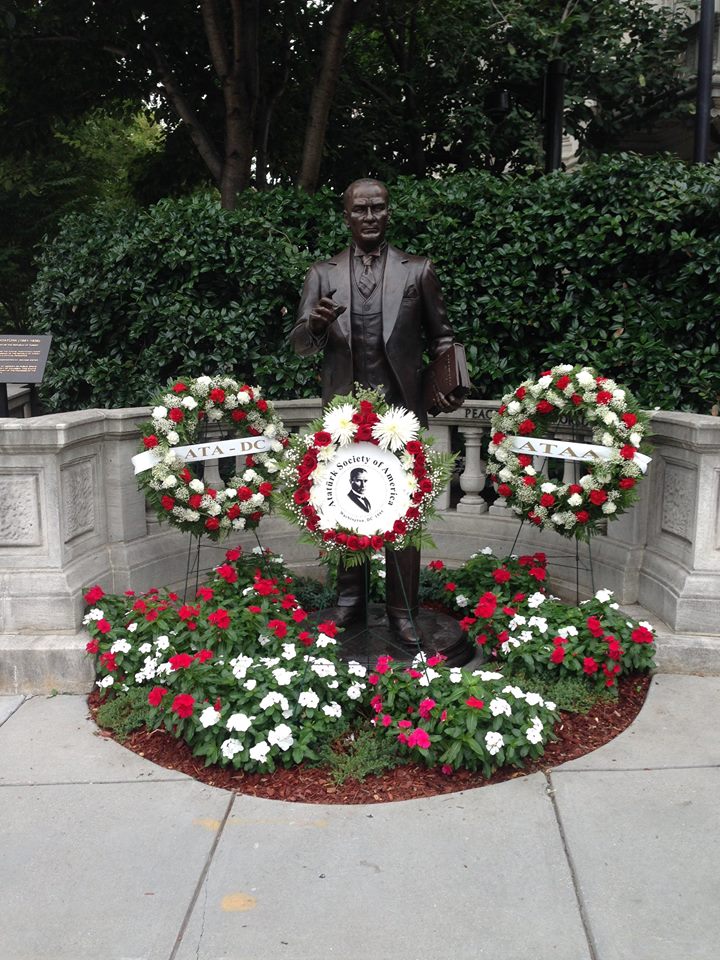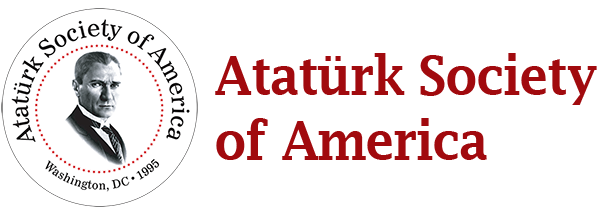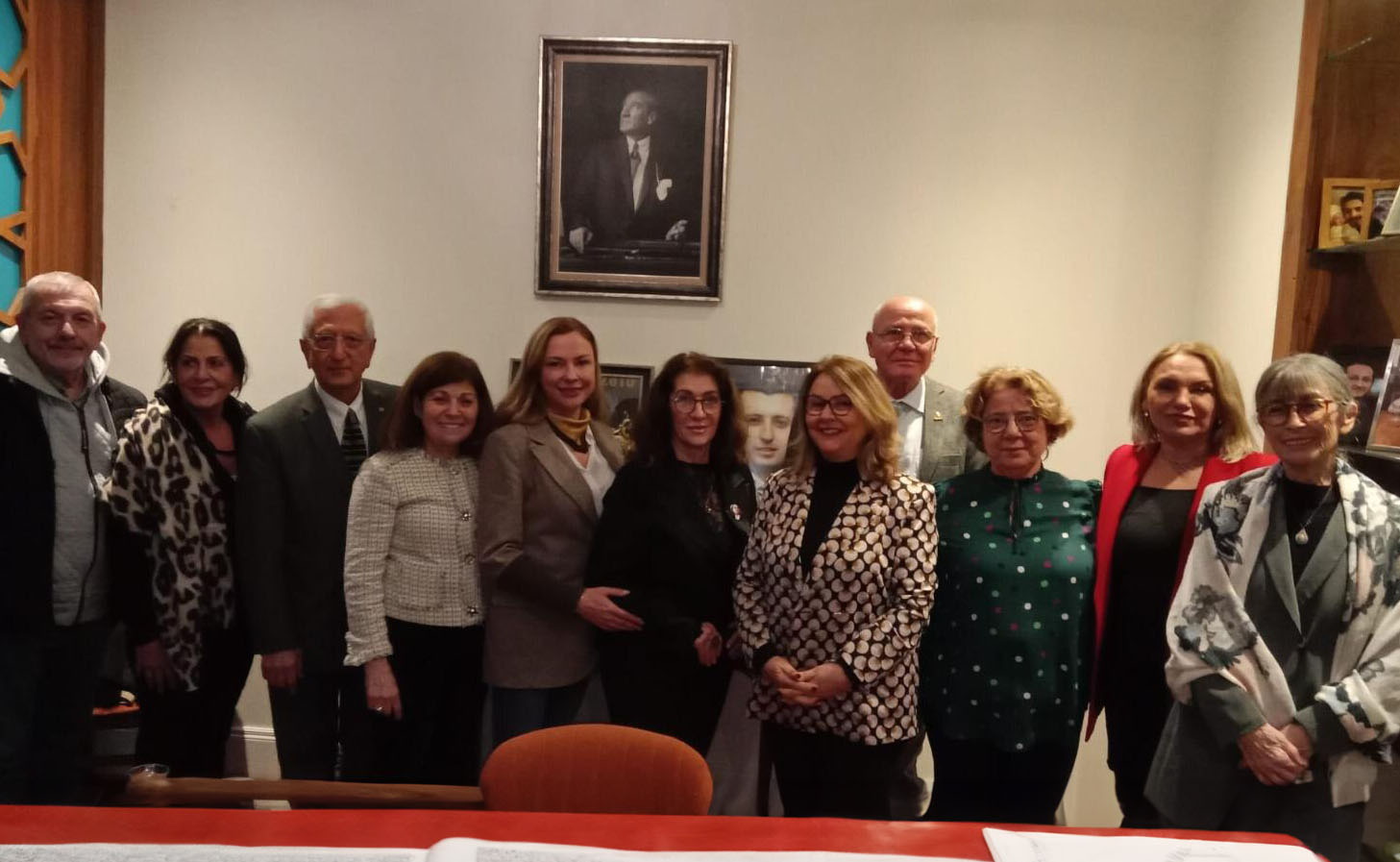
A DEFINING STATUE OF KEMAL ATATURK
“The new statue of Atatürk represents the first public monument in the United States honoring one of the greatest leaders of the 20th century.”
At a Board Meeting of the Atatürk Society in October 2012, the Founder of ASA, Hudai Yavalar, announced that the Society might have an exciting new project on its plate — the creation of a bronze statue of Atatürk to be placed on the periphery of Sheridan Circle, next to the Turkish Ambassador’s Residence at 1606 23rd Street, NW, Washington, DC. This would be the first public monument in the United States honoring the greatest Turk of them all, and coincide with both the 90th Anniversary of the founding of the secular Republic on October 29, 1923 and the 75th Anniversary of Atatürk’s death on November 10, 1938. Although no one on the Board had any direct experience with commissioning a monumental bronze, this immediately became an enticing project for those of us who genuinely revere Atatürk.
A full-size statue already stands on the grounds of the New Turkish Embassy at 1625 Massachusetts Avenue, but it is not readily accessible to the public, standing on raised ground and behind a massive wrought iron fence surrounding the Embassy. Moreover, it is in the style of Eastern European heroic statuary, made of fiberglass, and over-painted in bronze tones. We thought Atatürk deserved better. The Turkish-American architect Nuray Anahtar drew preliminary plans for the new statue to be placed at the center of a semicircular balustrade, an indentation in the wall surrounding the Turkish Embassy’s Residence at 1606 23rd statue. What made the site unique was its location squarely in DC public space rather than on Embassy property. As such, the statue would represent the first public monument in the United States honoring one of the greatest leaders of the 20th century. The consensus of the Board of the Atatürk Society was to have Kemal Atatürk depicted in a timeless realistic style, with the medium bronze. Selecting the sculptor, closely overseeing the carving of the work, and procuring permits from a plethora of City Officials — the Advisory Neighborhood Commission (ANC), the DC Board for Public Spaces, and the Historic Preservation Commission — were some of the tasks facing us. We also had to make a decision regarding the age to depict Atatürk — a young military officer struggling with battle strategy and wearing a uniform replete with a “kalpak” (fez); as the new President of the Secular Republic that he founded, and still wearing a fez; in the early 1930s, svelte, but an elegant modern man. We even debated how Atatürk personally would have wanted to be depicted. There was consensus in the Committee’s decision: he was to be a thoroughly modern man, determined and exuding that legendary confidence. Finally, we had to have the final product produced in record time.
We had a small list of four talented sculptors to invite to the competition, one in Azerbaijan; another in Salt Lake City, Utah, and the other two, young local artists who lived within an hour of Washington, DC. The names were given to me by a good friend, Lindy Hart, the widow of Frederick “Rick” Hart” (1942-1999) one of the greatest sculptors of the last quarter of the 20th century. Rick had carved “Ex Nihilo” above the Western Entrance of the National Cathedral. Then a few years later, he had created the bronze statues of the “Three Soldiers” at the Vietnam Memorial, standing in the shadow of the Lincoln Memorial — a realistic and extraordinarily powerful work. The two younger candidates had both worked for many years as Rick Hart’s assistants.
JEFFREY HALL, SCULPTOR
For Turks, images of Atatürk are fixed deep in their marrow. They have all spent their lives communing with images of Atatürk, and although they might have their own preferences, they can immediately assess whether an image produced by an artist even resembles Atatürk. Here, deciding to go with one of the two younger sculptors turned out to be a crucial salutary decision. Jeffrey L. Hall, lived no farther than one-hour’s distance from Washington, and he insisted that he could produce the finished art piece in roughly six months. We came to realize that he was always open to suggestions, and always willing to make changes. A few of us made at least a dozen visits to his studio in rural Virginia to oversee the latest changes, only to offer new suggestions. What we feared was the well-worn aphorism, “A camel is a thoroughbred designed by a committee!” What gave us confidence, however, Jeff’s legendary master, Rick Hart’s description of his former assistant’s skills, “…whose quality of work rivals any in history.” Jeff knew nothing about Atatürk in advance. But as he immersed himself in the hundreds of photos and even old films that captured his subject’s general demeanor and movement, he became as familiar with Atatürk’s deportment as any Turk. Meanwhile, we watched as his subject came to life. Standing next to the 6’7” bronze statue, perched on a 3” bronze base, one can sense Atatürk’s figure exuding that abstract quality described in Turkish as, “heybetli,” an unmistakable heroic presence.
As the author of a pair of books on Leonardo da Vinci (Math and the Mona Lisa, Smithsonian Books, 2004) and Leonardo’s Universe (National Geographic Books, 2009) I could bring suggestions based on my knowledge of the Renaissance Genius’s own words. Leonardo in painting “The Last Supper,” had emphasized the importance of the hands, “The subject should speak with his hands as much as with his facial expressions.“ From the beginning I frequently spoke about Leonardo’s dictum regarding the importance of the hands. In Jeff’s statue, Atatürk is depicted as a reformer/teacher, giving a speech — his left hand is holding a heavy book with the title “Nutuk” (“Speech”). The book is resting on his hip, but with his index finger holding his place in the book. The right hand captures the electric moment when he has paused, to make a point with his index finger. His intensity is seen in the details of the bulging veins.
Among other details, Jeff is seen to have captured Atatürk’s “renkli gözleri” (“light colored eyes”). We all marveled at how a dark bronze statue could convey the illusion of light colored eyes. The irises are much shallower than they would otherwise be in depicting a subject with dark eyes. Among the accompanying photos, a white plaster bust, cast directly from the mold for the bronze, reveals this technique. Another subtle detail that few visitors would be expected to recognize is the direction of the stripes on Atatürk’s tie. Mathematically speaking, these stripes display “negative slope” (upper left-to-lower right). This style of stripe is known as the “American Stripe.” In distinction, the European (or Asian) striped ties always display positive stripes (lower left-to-upper right). In examining photos of Ataturk wearing ties, we found that his ties of choice had the American Stripe. One can only speculate about his personal collection of ties being presented to him by the American Ambassador in Ankara, or one of the Turkish Ambassadors who once occupied the Embassy in Washington. The details also include the chain for his pocket watch, draped naturally across his vest; and in homage to his military days, his medal, partially covered by his right lapel.
The English poet William Blake (1757-1827) had once written the couplet, “Mysteries will never cease; the Priest clamors for war, and the soldier peace.” He could not have been more prescient, or more accurate, in describing Atatürk. The unrivaled military tactician and strategist, who was undefeated in the military campaigns that had consumed the first three decades of his life, then becoming the greatest proponent for peace once he established the Republic of Turkey. In the semi-circular balustrade surrounding Atatürk’s statue, we impressed into the walls bronze letters carrying his immortal words, “Peace at home… Peace in the World.”
SHERIDAN CIRCLE
The address, Sheridan Circle, is at the top of any short list of prime real estate in Washington, with the Embassy Row of Massachusetts Avenue radiating east west from the circle. Several embassies line the rim of the circle. Along with the former Turkish Embassy (now the Ambassador’s Residence) there is the Romanian Embassy on the southern side, the Greek Embassy on the northeast, and the Embassy of Pakistan on the northwest. In front of a few of the embassies stand statues of prominent statesmen, including Greece’s early 20th century Prime Minister, Eleftherios Venizelos, whose armed forces had fought Turkey until 1922, and who nominated Kemal Atatürk for the Nobel Peace Prize in 1934. The centerpiece of the circle is an equestrian statue of the Union General Philip Sheridan, of the American Civil War fame. Although the equestrian statue, weathered naturally to a verdigris patina during the 105 years it has stood at the site, is extraordinarily beautiful in its own right, it is the sculptor of the statue, Gutzon Borglum, who is to be remembered. Borglum is far better known as the sculptor of the heads of Presidents at Mount Rushmore in South Dakota. The newest of the four was the 26th President, Theodore “Teddy” Roosevelt, a good and colorful President, but one who does not rise to the stratospheric prominence achieved by the other three. For Teddy Roosevelt the timing was right: he was the reining President, he was unusually fond of the Wild West, and he was a friend of the sculptor.
The other three — Washington, Jefferson, Lincoln — are unrivaled as the greatest among the 44 Presidents in the history of the United States. The First President, General George Washington, unfaltering military leader who ultimately defeated the British, stands symbolically as the “Father of the Nation,” The Third President, Thomas Jefferson, a brilliant theorist and political writer, authored the Declaration of Independence. Jefferson also strongly believed that religion was a personal choice that that should be free from government interference. Then there is Abraham Lincoln, the Sixteenth President, who beyond anyone else held the United States together during the dark years of the Civil War. He authored the Emancipation Proclamation, although it would take the better part of a century for this proclamation to fully take root. Each member of this iconic trio is honored with an impressive edifice, his own National Monument in Washington.
Atatürk embodies the greatest assets of Washington, Jefferson and Lincoln — military strategist par excellence; social, educational and economic reformer; statesman — Father of his Country — the man the distinguished professor of psychiatry, Arnold Ludwig, ranked Number One among all 2300 national leaders of the 20th century.
LATEST POSTS
Recent Events, Articles & News
The Atatürk World Platform (ADDP) Ordinary General Assembly Meeting was held on 25 November 2023 in London England
The Atatürk World Platform (ADDP) Ordinary General Assembly Meeting was held on 25 November 2023 in London England. The 2nd Ordinary General Assembly Meeting of ADDP, of which the Ataturk Society of America is one of the founding...
100th anniversary celebration of the Turkish Republic
Ataturk Society of America (ASA) held its 100th anniversary celebration of the Turkish Republic at the Cosmos Club in Washington, D.C. on October 11, 2023. The program featured unforgettable musical presentations by guest artists, as...
ASA’s Commemoration of Atatürk Event November 6, 2022
Atatürk Society of America - ASA’s Commemoration of Atatürk event was held in Washington, D.C. on Sunday, November 6th., at the George Washington University (GWU) with the contribution of the Turkish Student Union. The ceremony was...
Aysegul Durakoglu is elected to serve at the Global NGO Executive Committee (GNEC)of the UN
Ataturk Society of America- ASA’s long time member and supporter, pianist Aysegul Durakoglu was elected to serve as a Director of Global NGO Executive Committee (GNEC) at the United Nations from 2021-2023, for a two-year...





